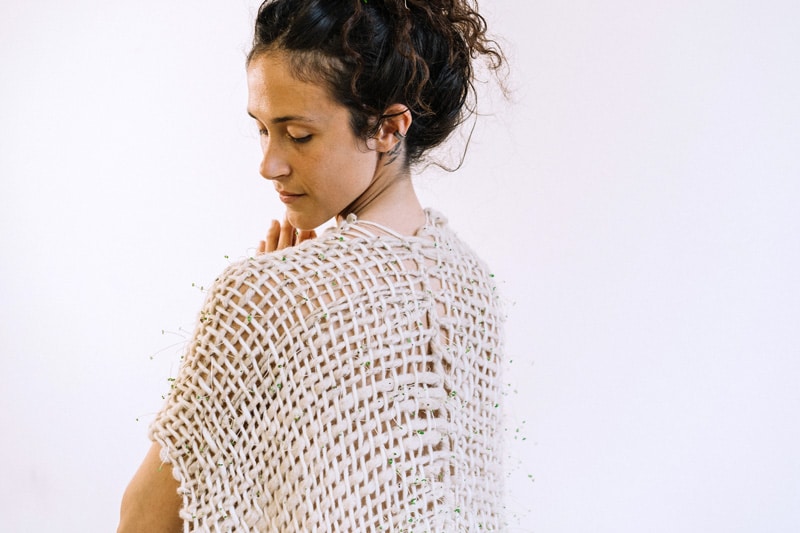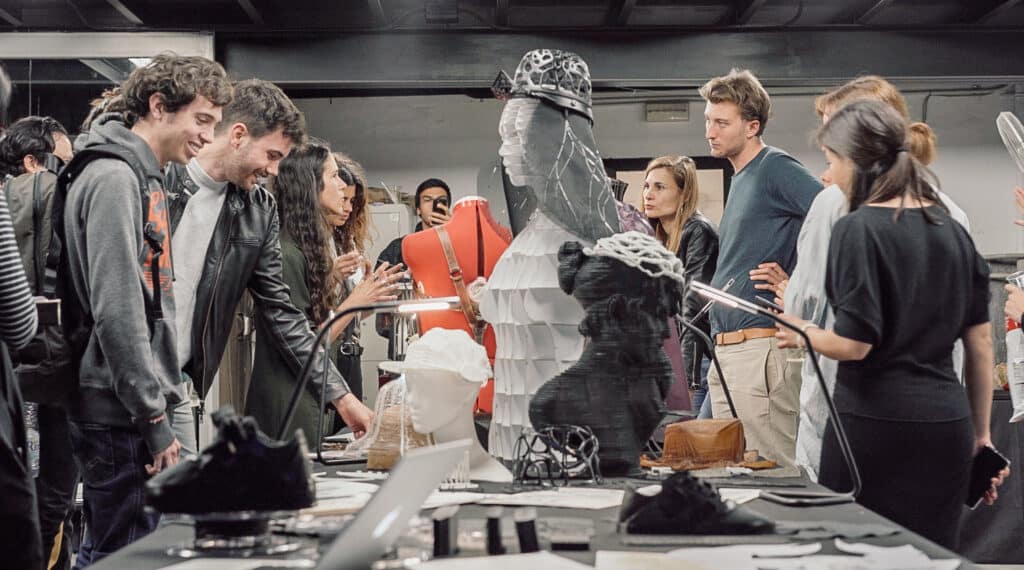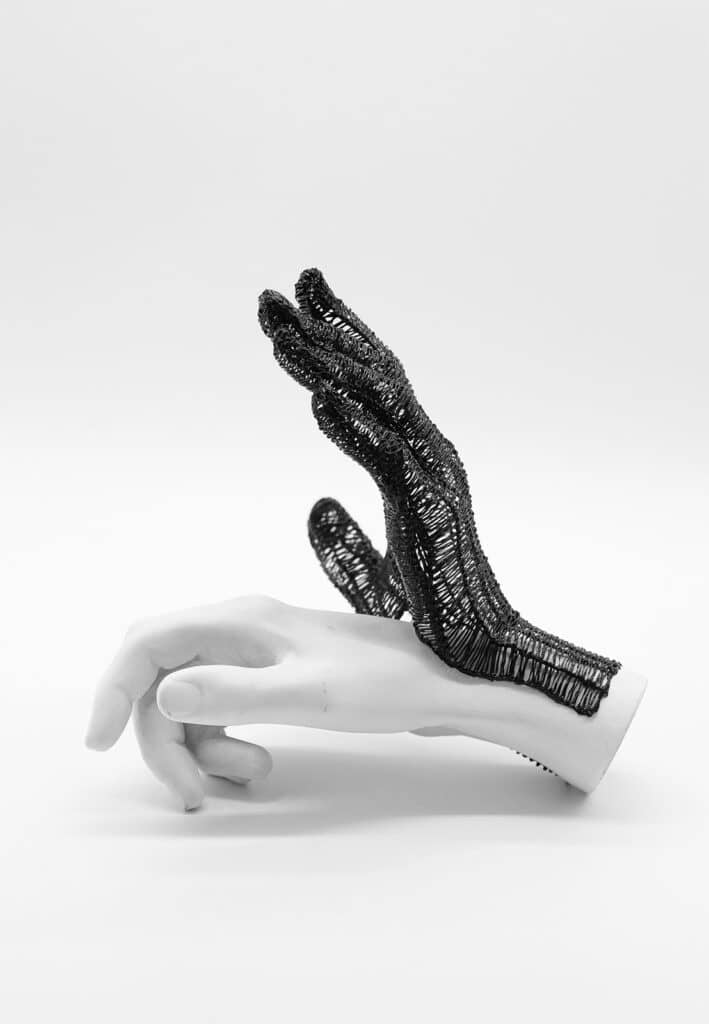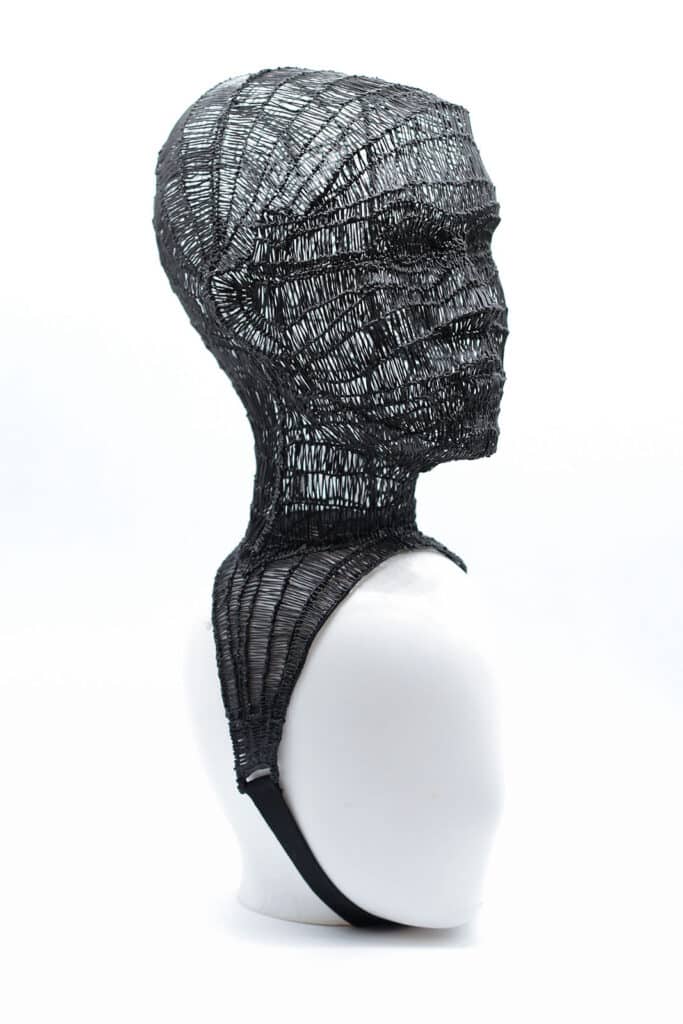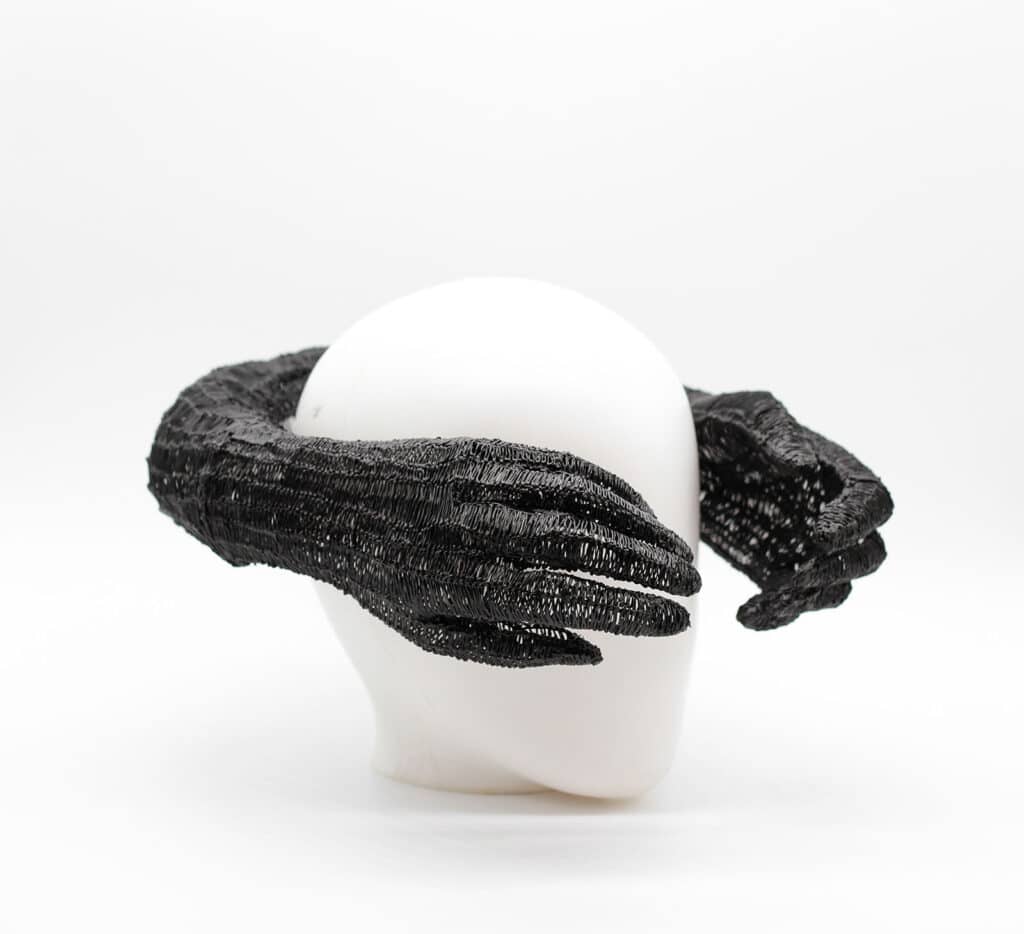
The intersection between fashion, art and science
We looked to experts from our local course, Fabricademy to find out more about the future of fashion
What’s hot?
Wearables. Wearables are taking a new form, exploring the relationship between you, your body and our planet. A fashion wearable can also be known as smart clothing, in which small electronic devices or microcontrollers, are embedded within clothing or (on) the body. Fashion wearables have in fact existed since around 1500, in which the German inventor Peter Henlein created small watches worn around the neck. Developments of wearables have hugely advanced since 1500 in the complexity of technology and design. Fashion wearables are setting new trends – questioning our knowledge and relationship between our bodies and sometimes, our planet. Fabricademy Barcelona 2019 graduate Ana Correa designed and 3D-printed her ‘HipHop E-Shoes’ (image below) which translated dancers movements into interactive visuals and sound. Lara Campos (image below) worked on embedding nature within her design ‘beGROUNDED’ as a method of artistic exploration. The shawl has seeds sewn within, designed for you to experience, feel and grow with nature.
click to tweetFashion wearables are setting new trends – questioning our knowledge and relationship between our bodies and sometimes, our planet.
Tangible interfaces
Fashion wearables are not just cuboid watches which measure heart rate, body temperature and encourage you to take your daily 10,000 steps. Fashion wearables are and can be smartwatches, however, they can also be much more subtle, working at the intersection between fashion, art and science. Wearables have progressed enormously in terms of design, functionality, accuracy and weight.
click to tweetFashion wearables are not just cuboid watches which measure heart rate and body temperature.
Some wearables are becoming more embedded in our biological systems – for example, the recent work by MIT Media Lab, The DermalAbyss project, in which a ‘tattoo’ (biosensor) changes colour in relation to blood sugar levels. The emergence of wearables which are deeply embedded in a different culture, in fact, signal a change in our perception of wearables – what a wearable is and what a wearable could be and could do. Further, the tattoo signals a potential perception change in our ‘traditional’ medical methods, in which clunky medical equipment could take a new form. The biosensor inks measure the shift of interstitial fluid in your skin, changing colour based on levels of glucose, sodium or pH. This was a research project which speculates on the possibilities of biosensors as a tattooed interface.
Fabricademy Barcelona
Fabricademy Barcelona is a transdisciplinary course that focuses on the development of new technologies applied in the textile industry, in its broad range of applications, from the fashion industry to the upcoming wearable market. Projects developed by Fabricademy Barcelona range from working with bio-based materials, 3D-printed shoes, to implementing wearables into fashion. Wearables can also help us connect with our bodies and our partners. The Fabricademy Barcelona graduate project Abobe by Ana San Roman is a unique lingerie project which encourages empathy and playful interactions between sexual partners. When touched, capacitive sensors detect touch and reproduce this through vibrations in other parts of the body.
click to tweetBIG NEWS! Fabricademy Barcelona is now an official UPC Universitat Politècnica de Catalunya programme! 🔥
Digital fabrication is not just changing our relationship between our bodies and our clothes, it’s also transforming the way in which we produce and design clothes. The use of fabrication technologies and CAD programs means that we can design parametric pieces of clothing which can be printed, cut and sewn to make bigger pieces. This is promising for the fashion industry – reducing material waste but also opening the doors to parametric designs. For example, 3D printed textiles can mimic traditionally used natural or animal skins for fashion. In the Digital Python project, 3D printed interlocking textiles create the bold snake print – see in the image below (Fabricademy Barcelona alumni Juan Felipe Enriquez Fiallo at Digital Made / Alta Roma).
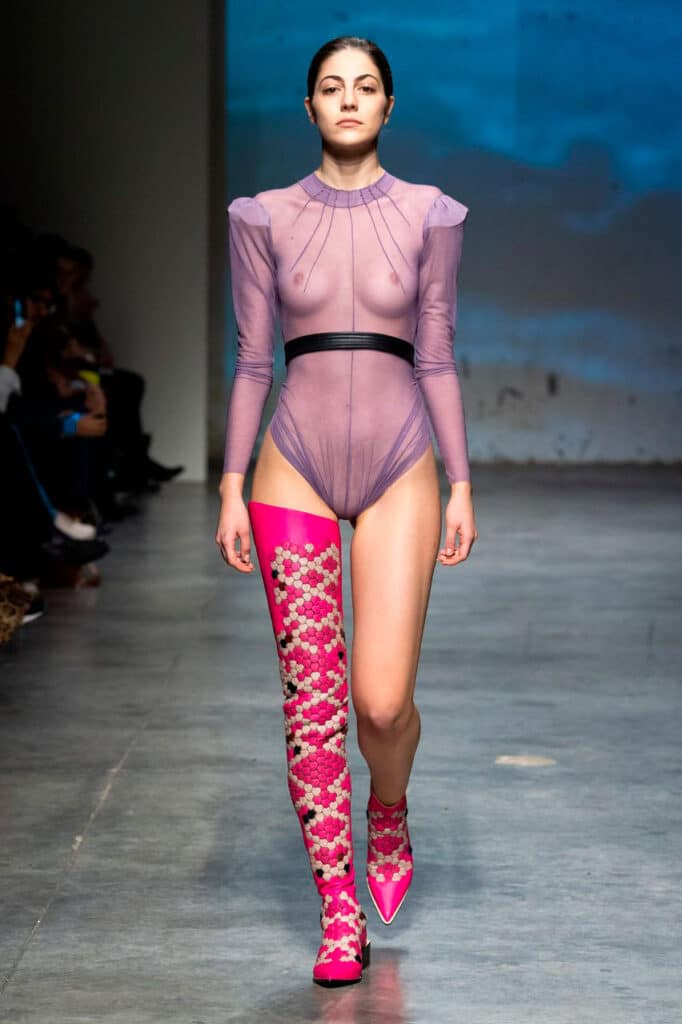
Spotlight on Fabricademy Barcelona 2019 graduate Betiana Pavón
Betiana Pavón graduated from Fabricademy Barcelona in 2019. Betiana is Creative Director of the “Alaska Accessories” brand, which focusses on revaluing and adapting the traditional millinery to a contemporary environment and wearers. In this context of communion between art and design, she has been a winner and recognised in international competitions from the Mercedes Benz Fashion Week, Vogue Spain, Madrid Fashion Week and 2019 Winner of Samsung EGO Innovation Project with her Fabricademy Barcelona project ‘Deconstructive Heads’. We asked Betiana for a quick interview to understand about her passions, motivations and design style.
How is digital fabrication transforming fashion?
“Digital fabrication allows things to be designed, manufactured, distributed, stored, and sold in another way. The traditional and old economy of scale is based on the search for margins through quantity, not quality. The profit margin depends on the volume and in the end, we have ended up overloading the world with things that nobody needs. Digital fabrication, in its different and wide alternatives, changes all that. It provides us designers with everything necessary to manufacture in a way that is not only more sustainable but also competitively and creatively. Digital design allows to view and correct details in a part or object before being manufactured, modify scales and sizes just by modifying parameters. This also allows to digitally display and market products in the form of data, reach customers and audiences without geography limited.“
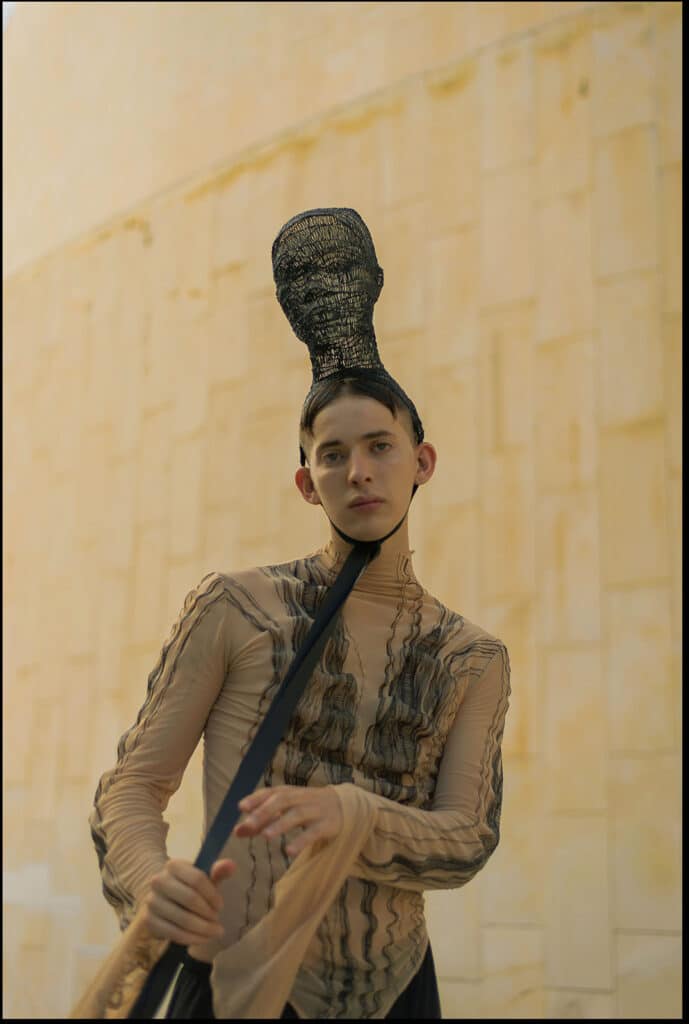
You graduated from Fabricademy Barcelona in 2019, how did the course combine your interests to reach where you are now?
“Fabricademy Barcelona changed the way I thought about, projected and materialised my designs. It opened a world of new possibilities and alternatives (many of which I still want to continue exploring). Before, my way of working as a head accessory designer was also related to the model currently known as “slow fashion” or “ultra-personalised”. This direct relationship between Creator – Client goes back to the origins of the trade of the millinery, where each person could order a custom hat, select materials, colours and finishes; in a completely manual and artisanal way. The current course of my project aims to revalue this trade and take to a contemporary situation and wearers.
Along this path, Alaska currently incorporates new technologies, both in software and hardware, for the design and construction of its accessories and pieces; emphasising the use of 3D printing, additive manufacturing: everything is built by making a layer on top of another layer, no waste is generated and, in addition, it allows to use recycled materials, as well as biodegradable materials. This way, there are no discarded, unused or wasted materials, as most of the products are also made to order. Making use of digital resources to achieve a more sustainable and conscious production model was one of the most valuable lessons that Fabricademy Barcelona has left me.“
You’re the Creative Director of Alaska Accesorios, can you describe your practice and the type of work you do?
“Alaska Accessories (to be carried on the head) is a project that I have been carrying out for a few years and that comes with me from Argentina. Like me, it finds itself re-defining, mutating towards a new concept, where the constant fusion between technology and craftsmanship defines the aesthetics and morphology of each piece. In the future, my idea is that the brand can become a service, created than a defined product; and thus to be able to dialogue, collaborate and interact with other disciplines (such as plastic, visual and performing arts). I am interested in leaving the pre-established limits that the fashion industry imposes on us and that an “accessory” can be worn by someone on a runway or on the street and at the same time in an art gallery, due to its quality of being unique. Taking the human body as inspiration and support for my creations, allows me to create a connection between my trade related to fashion and the understanding of our evolutionary relationship with this industry.“

Where has your work been shown and what are you most proud of?
“I have shown my work on the runways of “ALTAROMA” 2019-20 (Italy) Mercedes-Benz Fashion Week Madrid 2019, digitally at Mercedes-Benz Fashion Week Russia 2020 “GLOBAL TALENTS DIGITAL” contest; in innovation and design exhibitions such as “Reshape Forum”, “Maker Faire” (Barcelona), “FAB15” (Egypt) and in galleries or contemporary art platforms, such as “Haimney Gallery” (Barcelona) in the present. The biggest achievement was winning the “Samsung EGO Innovation Project” last year, as it gave me the opportunity to develop a complete collection of interactive hats and display it on an exclusive catwalk of the brand, at international level.
I am also very proud of “Radiorator”, a growing collective project of which I am a member together with Agustina Palazzo (visual and sound artist) and Mateus Sartori (architect). I am inspired and nurtured by multidisciplinary work and this project speaks of it – it was born with a premise inspired by the cultural and intellectual movement “transhumanism” which is based on the philosophy that we can and must improve the quality of life using technology. It consists of a portable device (helmet) that allows listening to broad-spectrum radio frequencies, manifesting the sound of the invisible in a performative act.“
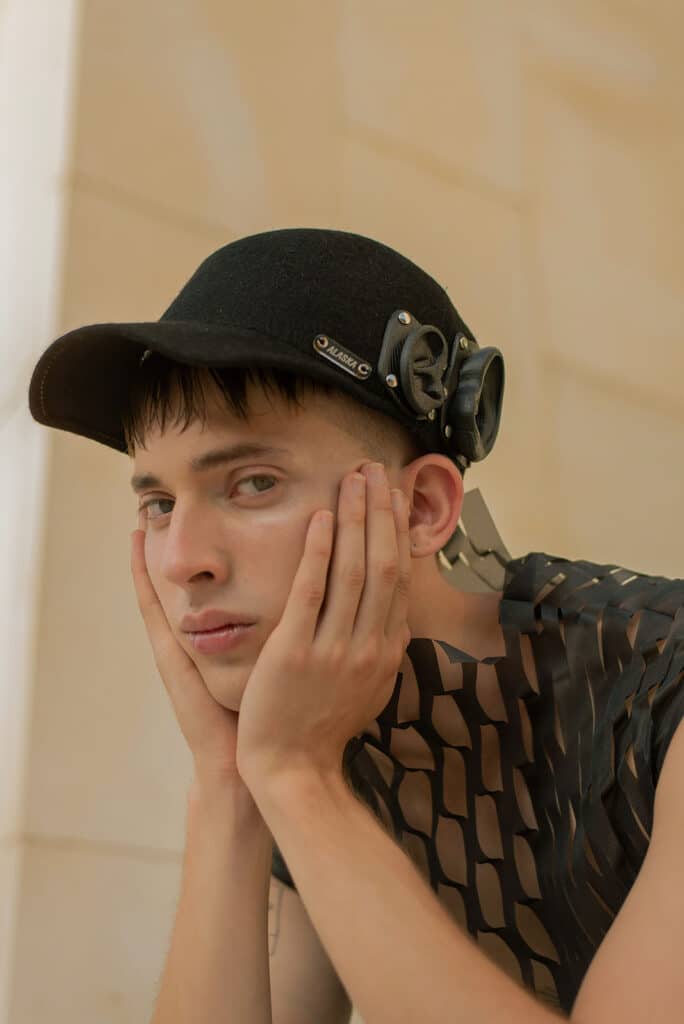
What do these projects mean for the future of wearables? The projects suggest that fashion wearables are transitioning away from wrist-gadgets, towards more fluid designs which explore the role between our biological systems, the planet and the future. These projects also alter the way in which we think about the industrial process of fashion, through small-scale personal manufacturing, these projects explore new ways of living, breathing and wearing not only fashion but also, other organisms.
Do you want to be the next pioneer in wearables?
- Find out more and apply for Fabricademy Barcelona – note! The deadline for applications is soon!
- Go to the Fashiontech Berlin Conference
Mentioned in the article
- DuoSkin by MIT Media Lab
- DermalAbyss by MIT Media Lab
- Living Tattoo by MIT
- Follow Betiana’s work at Alaska Accesorios and social media handles – @betiana_jpg, @alaska_accesorios and @radiorator.project

